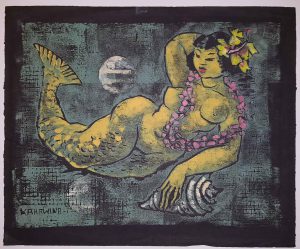(Click to Enlarge)
Woodcut on paper
15 1/8 x 18 1/2 inches as a complete piece
Signed in graphite Erica Karawina lower right and #5 Melancholy Mermaid
Tape remnant top, corner crease lower left and a few minor corner tears
Last origin Boston, MA
Erica KARAWINA (1904-1989)
Birth place: Wittenberg, Germany
Addresses: Boston, MA; Honolulu, HI
Profession: Designer, painter, sculptor, lithographer
Studied: study in France; Boston, with Frederick W. Allen & Charles J. Connick.
Exhibited: Dance Int., Rockefeller Ctr., 1937; competition of State of Massachusetts, NYWF, 1939; Boston AC; S. Indp. A., Boston; PAFA; Oklahoma A. Center; Grand Rapids A. Gal., 1940; Grace Horne Gal., Boston (solo); Univ. New Hampshire, Durham, 1937; Lancaster (PA) AC, 1937; Wadsworth Atheneum, 1938; Texas State Col., 1939; Honolulu Acad. Arts, 1952 (John Poole Mem. Prize); Narcissus Art Festival, Honolulu, 1961(James C. Castle Award); Protestant Orthodox Ctr., NYWF, 1964; China Inst., Taipei, Taiwan (solo), 1965.
Member: Honolulu Print Makers; Hawaii Painters & Sculptors League; fel. Int. Inst. Arts; Nat. League Am. Pen. Women.
Work: AGAA; LACMA; Biro-Bidjan Mus., Russia; Les Archives International de la Danse, Paris; WMA; MMA; MoMA; BMFA; LOC; Honolulu Acad Arts, Hawaii. Commissions: sea pattern (leaded glass), Commissioned Off. Club, Pearl Harbor, Hawaii, 1961; 20 lancets of faceted glass in concrete, Robert Shipman Thurston, Jr. Mem. Chapel, Punahou School, Honolulu, 1967; “Crux Gemmata” (glass in concrete) Manoa Valley Church, Honolulu, 1967; six windows of sculptured glass, St Anthony’s Church, Kailua, Oahu, Hawaii, 1968; sculptured glass, “This Earth is Ours,” News Bldg. Foyer, Honolulu Advertiser, 1972; stained glass, churches in San Francisco, Denver, Chicago, Cincinnati, NYC, Paris; Colo. Springs FA Center.
Comments: Preferred media: stained glass. Publications; contrib., “From Maui to Mainz,” 1956-57 & “From Hawaii to Holland,” 1963, Stained Glass. Teaching: draftsman stained glass, Co. Studios, Boston, 1930-33; des. stained glass, Burnham Studios, Boston, 1935-38. Art interests: leaded & faceted sculptured glass.
Sources: WW73; WW47; Jean Charlot, “Exhibition of Stained Glass,” May, 1953, Harriet Ghee, “Island Artist Erica Karawina,” July, 1955 & Joanne Shaw, “Echoes of Universality,” Vol. 72, No 9, Paradise of Pac. ”
Renowned artist Erica Karawina
By James Gonser
Advertiser Staff Writer
Erica Karawina said “the daylight in Hawai’i is superb” for her stained-glass art, which can be seen in many churches and other buildings.
Erica Karawina, a renowned stained-glass artist whose works adorn many churches, businesses and public buildings, died April 19 in Honolulu. She was 99.
Karawina’s work can be seen in dozens of places in Hawai’i, from the front of The Honolulu Advertiser’s News Building, to the massive ceiling skylight in Ka’ahumanu Hale (First Circuit Court), to the four large stained-glass mosaic murals around the crown of the State Office Building, Kalanimoku Hale.
Manoa Valley Church, Lili’uokalani Protestant Church and Church of the Epiphany in Kaimuki are just a few of the houses of worship that have windows made by the artist.
“The daylight in Hawai’i is superb for this,” the artist said in 1977.
Karawina was born Jan. 25, 1904, in Germany and moved to the United States in 1923.
She studied with sculptor Frederick W. Allen, head of the Boston Museum School, and with Charles J. Connick, who created the stained-glass windows in the Cathedral of St. John the Divine in New York City and Chicago’s First Presbyterian Church.
Karawina likened her art education to that of a medieval apprentice who learned the craft through careful observation and practice.
“An artist has to be humble in this medium and subservient to the material,” Karawina told The Advertiser in 1961. “It is from the black that stained glass derives it strength. Just as when one looks at a tree silhouetted against bright sunlight and the sun seems to dissolve the tree, so the brilliance and reflected light in colored glass dissolves, yet depends on, the black web of lead.”
Karawina also did wood cuts and lithographs in the 1930s that were frequently displayed in galleries including the Library of Congress and the Metropolitan Museum in New York.
She met her husband, Sidney C. Hsiao, while he was studying at Harvard University, and they were married in 1938. In 1941, the couple were in China when World War II broke out and forced to stay there for the duration. Hsiao taught in a school near the Tibet border, and Karawina focused on painting, learning to incorporate Asian influences into her art.
After the war, they moved to New England and then to Honolulu in 1949, where Hsiao became chairman of the University of Hawai’i’s zoology department.
Working from her Manoa home, Karawina created dozens of stained-glass murals and developed what she called a “faceted glass works” using rough-hewn glass resulting from hammering and chiseling pieces that were then placed in a frame and embedded in epoxy.
Hsiao died in 1972, and Karawina has no known survivors. A celebration of her life is pending.
Source:hawaiiadvertiserdotcom




